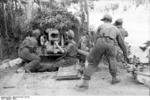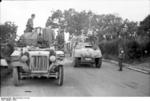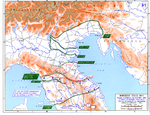Gothic Line Offensive
Contributor: C. Peter Chen
ww2dbaseThe Gothic Line, renamed Green Line in Jun 1944, was the final main German defensive line in northern Italy. The line stretched from the area south of La Spezia on the west coast of Italy through the Apennine Mountains to the area between Pesaro and Ravenna on the east coast. It featured 2,376 machine gun nests, 479 gun positions, concrete bunkers, barbed wire, anti-tank ditches, and natural terrain favoring the defenders. By Aug 1944, the Germans in Italy were plagued with increased Italian partisan activity behind the front lines, while the Allies commanders in Italy were frustrated by their superiors transferring forces under their control for the new front in France; by the first week of Aug, strength of British 8th Army had fallen from the height of 249,000 men to about 153,000, for example. Although France now became the main front for the Allies to break into the heart of Germany, the Italian campaign was not canceled, as it had political value. If the American and British forces were able to take northern Italy, they would have a chance to advance further north into Austria and Hungary to lessen post-war Soviet influence in that region.
ww2dbaseOperation Olive was launched on 25 Aug 1944. On the Adriatic Sea coast in eastern Italy, Oliver Leese's British 8th Army assaulted the eastern end of the Gothic Line. Troops of Polish II Corps and Canadian I Corps spearheaded the attack, finding surprised German defensive positions. Albert Kesselring, the German theater commanding officer, was unsure whether this attack was to be the main assault and held on to his reserves, fearing that the US troops stationed south of Bologna might launch the actual main attack. On 28 Aug, captured Allied document revealed that the British 8th Army indeed was part of the main effort, and Kesselring released three reserve divisions to the coastal area; it would take them two to three days before they could arrive and become ready for combat. Meanwhile, British, Polish, and Canadian troops pushed through the Green I defensive positions and reached Green II defensive positions, threatening the city of Rimini. In the first two weeks of Sep, British and Indian troops engaged in a series of heavy fighting on Gemmano, held by troops of German 98th Division; it took the Allies 12 separate attempts before finally wearing down the defenders and capturing the town. In an attempt to safeguard the German flanks, German troops marched into high grounds in the neutral country of San Marino, located southwest of Rimini; on 17 Sep, Indian 4th Division attacked San Marino, capturing the small country after three days of fighting against troops of German 278th Infantry Division. On 21 Sep, Rimini fell to troops of Greek 3rd Mountain Brigade of Canadian 1st Division, with New Zealand 20th Armoured Regiment in support. Just as progress was made, however, the autumn rain season began, swelling rivers and flooding roads, slowing but not stopping the advances. In late Sep, Lieutenant-General Richard McCreery replaced Oliver Leese as the commanding officer of British 8th Army.
ww2dbaseMark Clark's US 5th Army launched the second arm of the attack in the Apennine Mountains toward Bologna at dusk on 12 Sep, about three weeks after British 8th Army. Monte Altuzzo and Monte Pratone were captured by 17 Sep, and the key Il Giogo pass was taken four days later. Around this time, Clark decided against the capture of Bologna, instead moving east toward Imola in an attempt to encircle German 10th Army; a few days later, as the advance toward Imola grounded to a halt, he switched his attention back at Bologna. A fresh offensive by US and British troops was launched toward Bologna on 5 Oct, which again saw very slow progress.
ww2dbaseIn the first week of Oct 1944, British 8th Army launched a new offensive, forcing Kesselring to consolidate his defenses at Bologna. On 16 Oct, US 5th Army launched yet another new offensive toward Bologna, with US 88th Division capturing Monte Grande four days later and British 78th Division capturing Monte Spaduro on 23 Oct. The US 5th Army attack stalled by the end of Oct. The British 8th Army advance made very slow progress through Nov and Dec 1944, capturing Forlì on 30 Oct, capturing Ravenna on 5 Nov, crossed the Cosina River on 23 Nov, and finally capturing Faenza on 17 Dec. As the German forces established new defensive positions along the Senio River, and the first snow of the winter about to fall, the British 8th Army's attack ground to a halt as well.
ww2dbaseThe Allies suffered 40,000 casualties during the Gothic Line offensive.
ww2dbaseSource: Wikipedia
Last Major Update: Mar 2013
Gothic Line Offensive Interactive Map
Photographs
 |  |
Maps
 |
Gothic Line Offensive Timeline
| 4 Aug 1944 | Harold Alexander met with Oliver Leese, who convinced Alexander to attack the Gothic Line in Italy by a thrust along the coast of the Adriatic Sea. |
| 25 Aug 1944 | British 8th Army launched Operation Olive against the eastern end of the German Gothic Line in Italy, with Polish and Canadian troops on the spearhead. |
| 27 Aug 1944 | Albert Kesselring noted that the recent Allied attack on the eastern end of the Gothic Line in Italy could be a diversion, thus he decided to hold on to his reserves. |
| 28 Aug 1944 | Albert Kesselring was given a captured copy of the Allied Operation Olive plans and learned that the recent Allied attack on the eastern end of the Gothic Line in Italy was part of a major offensive; he gave the order to move three reserve divisions from Bologna to the east coast. |
| 29 Aug 1944 | Allied forces entered the Foglia Valley on the eastern end of the German Gothic Line in Italy. |
| 30 Aug 1944 | Canadian armored units attacked Pesaro, Italy, but they were beaten back, losing 32 of 50 tanks in the process. |
| 31 Aug 1944 | US 5th Army crossed the Arno River in northern Italy as British 8th Army attacked the Gothic Line. |
| 1 Sep 1944 | Gurkha troops attacked Tavoleto, Italy. |
| 3 Sep 1944 | Canadian troops penetrated German lines and reached the Green II defensive positions on the Gothic Line in Italy. To the west, troops of British V Corps attacked German positions along the Coriano Ridge and advanced to the Marano River. |
| 4 Sep 1944 | British troops launched the first of eleven failed assaults on Gemmano, Italy. |
| 12 Sep 1944 | In the Apennine Mountains, US 5th Army launched a major offensive against the German Gothic Line in Italy. To the east, Canadian 5th Armoured Division and British 1st Armoured Division attacked Coriano, Italy. |
| 13 Sep 1944 | Coriano Ridge, part of the Gothic Line in Italy, was captured by Canadian troops. |
| 14 Sep 1944 | Canadian 5th Armoured Division and British 1st Armoured Division captured Coriano, Italy. |
| 15 Sep 1944 | Indian 4th Division drove out German 98th Division and captured Gemmano, Italy. To the north, British 56th Division captured Corce. |
| 17 Sep 1944 | US 85th Division captured Monte Altuzzo, Italy; other US units captured Monte Pratone. To the east, Indian 4th Division attacked German 278th Infantry Division in San Marino. |
| 18 Sep 1944 | Indian troops captured Point 343 in San Marino. Brazilian troops captured Camaiore, Italy. British troops captured San Godenzo Pass, also in Italy. |
| 19 Sep 1944 | Indian 4th Division reached the outskirts of the city of San Marino. |
| 20 Sep 1944 | Indian 4th Division captured San Marino in the early afternoon. In nearby Italy, Canadian troops broke through German lines along the Ausa River. At Rimini, Italy, Greek troops reached the southern outskirts of the city. |
| 21 Sep 1944 | In the morning, troops of Greek 3rd Mountain Brigade captured Rimini, Italy, which had been evacuated by the Germans overnight, and raised a Greek flag on the balcony of the municipal building; the mayor officially surrendered the city at 0745 hours. US 85th Division captured Firenzuola, Italy. Indian 4th Division withdrew from San Marino. |
| 22 Sep 1944 | US troops captured the Il Giogo pass on the Gothic Line in Italy. |
| 24 Sep 1944 | British XIII Corps captured Marradi, Italy. |
| 26 Sep 1944 | British 8th Army drove out German positions along the Uso River north of Rimini, Italy. |
| 29 Sep 1944 | British 8th Army reached the Fiumicino River in Italy. |
| 1 Oct 1944 | After a 4-day fight, the US 5th Army captured Monte Battaglia, Italy, a part of the Gothic Line defenses. |
| 2 Oct 1944 | US 5th Army reached Monghidoro, Italy. |
| 5 Oct 1944 | US II Corps, with British troops in support, launched a new attack toward Bologna, Italy. To the east, Indian 10th Infantry Division crossed the Fiumicino River, forcing German 10th Army to pull back toward Bologna. |
| 7 Oct 1944 | British 8th Army resumed attacks on the Gothic Line in Italy. |
| 12 Oct 1944 | American "Buffalo Soldiers" broke through the Gothic Line in northern Italy. The 92nd Infantry Division was the only black unit (with white officers) to see combat in Europe, going into action in Italy after the capture of Rome. |
| 16 Oct 1944 | US 5th Army launched a new offensive toward Bologna, Italy. |
| 20 Oct 1944 | US 88th Division captured Monte Grande, Italy. |
| 21 Oct 1944 | British V Corps crossed the Savio River in Italy. |
| 23 Oct 1944 | British 78th Division captured Monte Spaduro, Italy. |
| 25 Oct 1944 | British V Corps crossed the Ronco River in Italy. |
| 28 Oct 1944 | The US 5th Army offensive Bologna, Italy began to stall. |
| 30 Oct 1944 | British 8th Army reached Forlì, Italy. |
| 5 Nov 1944 | British troops captured Ravenna, Italy, cutting the rail line to Bologna. |
| 9 Nov 1944 | Allied troops crossed the Montone River in Italy. |
| 23 Nov 1944 | Allied troops crossed the Cosina River in Italy. |
| 17 Dec 1944 | Allied troops captured Faenza, Italy. |
| 26 Dec 1944 | In order to blunt the spearhead of a German advance at Sommocolonia, Toscana, Italy, US artillery observer John Fox called in strikes progressively closer to his own position until he called a strike on the house where he was located. He was killed by the final artillery barrage, along with approximately 100 German soldiers. |
Please consider supporting us on Patreon. Even $1 per month will go a long way! Thank you. Please help us spread the word: Stay updated with WW2DB: |

» Alexander, Harold
» Clark, Mark
» Fox, John
» Inouye, Daniel
» Leese, Oliver
Locations:
» Italy
» San Marino
- » 1,182 biographies
- » 337 events
- » 45,119 timeline entries
- » 1,249 ships
- » 350 aircraft models
- » 207 vehicle models
- » 376 weapon models
- » 123 historical documents
- » 261 facilities
- » 470 book reviews
- » 28,415 photos
- » 365 maps
Joachim von Ribbentrop, German Foreign Minister, Aug 1939